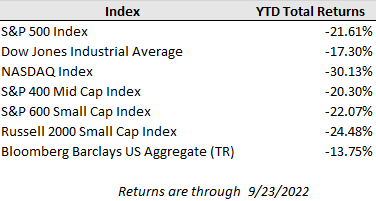U.S. equities remained under pressure last week, closing down for the second straight week, after the Federal Reserve's third outsized rate hike in a row. The S&P 500 posted a 4.6% loss on the week after falling in four out of five sessions. The decline was led by energy stocks, which fell after WTI crude oil slid below $80 per barrel for the first time since January in response to weakening economic growth expectations amid tighter financial conditions. The Fed raised its key lending rate by 0.75% to bring the target rate to 3.00-3.25% as the central bank tries to stamp out inflation. Investors are concerned that the Fed may be unable to provide a soft landing as they plan more rate hikes. Most Fed officials expect the fed funds rate to top 4.0% by 2022-end, and ultimately reach as high as 4.6% in 2023, according to the central bank's dot plot.
The Federal Reserve isn’t the only global central bank responding aggressively to uncontained inflation. In fact, the World Bank recently noted that “central banks around the world have been raising interest rates this year with a degree of synchronicity not seen over the past five decades — a trend that is likely to continue well into next year.” Soon after the Fed's move, the Bank of England raised its key interest rate by 0.50% to 2.25%, while the Swiss National Bank raised its benchmark rate by 0.75% to 0.50%, thereby bringing an end to an era of negative interest rates in Europe.
Tightening global financial conditions and expectations for falling economic growth have helped push energy prices lower as the world grapples with supply shortages. In the U.S., crude oil sales from the Strategic Petroleum Reserve were only supposed to last through October, after the Biden administration authorized the release of 180M barrels, due to inflationary shocks from the war in Ukraine. Now, another 10M barrels of strategic oil stocks will be put on the market for delivery in November, adding to the recent push of emergency sales to further reduce fuel prices. According to AAA, U.S. gasoline pump prices were averaging about $3.67 per gallon on Friday, down from a record of over $5.00 seen back in June.
In Europe, energy prices have also come down notably off their peaks though European natural gas still is up 127% compared to a year ago. Last week, U.K. government officials made an unexpected announcement of large tax cuts to boost economic growth and try to blunt the impact of rising food and energy prices for consumers. However, the announcement has been met with sharp market volatility on concerns of further stoking inflation and sent the British pound tumbling to its lowest level against the U.S. dollar since 1971 (down 21% this year).
European Union member states are also rushing to complete the eighth round of sanctions against Moscow following an escalation of its war in Ukraine. Vladimir Putin this week announced a "partial mobilization" that will conscript as many as 300,000 troops, while voting just began to annex the four regions of Luhansk, Donetsk, Kherson and Zaporizhzhia, which represent about 15% of Ukrainian territory. The referendums are due to run till Tuesday and may be used by Russia to justify further escalations to defend its newly incorporated provinces.
Amid the sharp market volatility and high near-term economic uncertainty that we are currently experiencing, it can feel more difficult for investors to focus on the long-term picture and stay the course with long-term plans and objectives. However, investors with a solid, well thought investment plan can remain confident that they are structured to weather the storm. Please feel free to speak one of our team of advisors if you want to discuss your investment plan.


